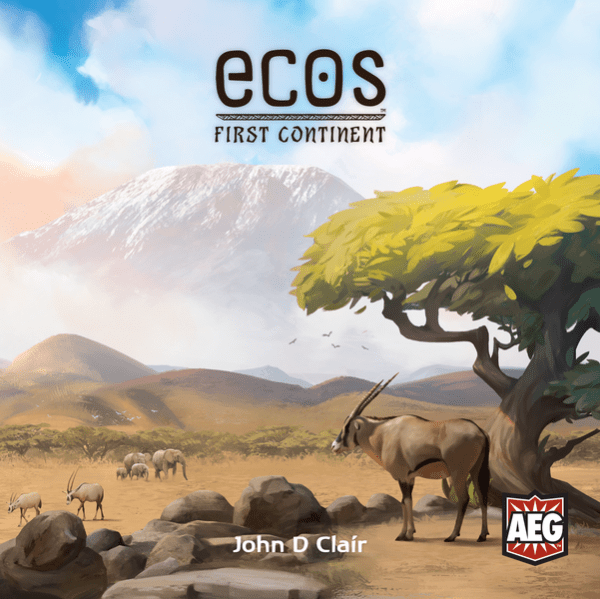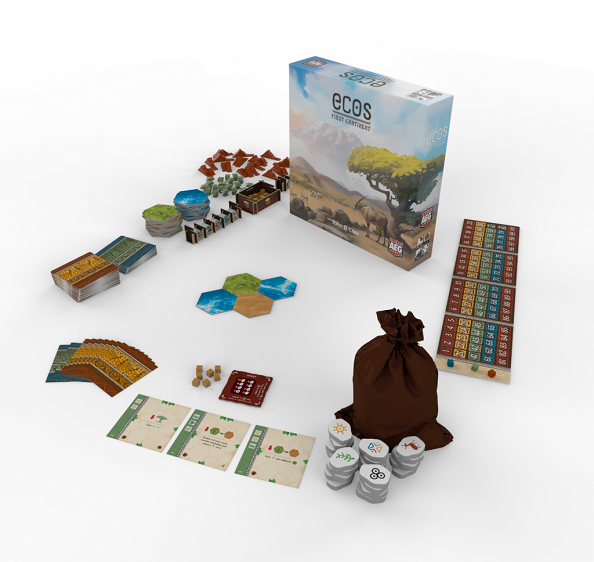Shape the World According to Your Vision in Ecos: First Continent

Players are forces of nature, working together to mold the earth according to their grand visions! However, each player has their own unique ideas for the planet, and while they build the planet together they are competing to lead the world towards their own ideas.
Published by AEG and designed by John D. Clair (the designer of Mystic Vale and Space Base), Ecos: First Continent features engine building, tile placement, and simultaneous gameplay.
Gameplay
Each player starts the game with seven energy cubes and a dial token. You also each start the game with twelve cards. Cards are marked with special icons so that when first learning the game you can have players start with pre-built hands, but on subsequent rounds you can choose to draft your hands instead. Nine of your cards start in your hand and three start on the table in front of you. There are two decks of cards, the brown deck and the blue deck. The brown cards tend to affect the game map more, while the blue cards tend to be worth more points.
At the start of the game four tiles are placed in the center of the table to begin the map: two water tiles, one desert tile, and one grassland tile. All forty element tokens are placed in the element bag, one player is chosen to begin the game as the harbinger, and you are ready to start.
Every turn, the harbinger draws an element token from out of the bag. Every player then checks the cards in front of themselves on the table. If a card shows an uncovered image of that element, you may cover it with one energy cube (if you are out of cubes, you may choose to move one from another card). You may only place one cube each turn. If none of your cards require the element that was drawn, or you choose not to use it, you instead rotate your dial token. The second time it is rotated, you can set it back to the start in order to draw a card (you may draw and look at two cards and choose one, or select a card a player previously didn’t choose when they took the same action). The third time it is rotated, you set it back to the start and either take a new energy cube for your supply or may play a card from your hand to the table in front of you so that you can start adding cubes to it on future turns.
Once all a card’s elements are covered, you call out 'eco'. Once everyone has finished placing their cubes, players take turns resolving their completed cards. You take the cubes from the filled card and place them back into your supply, and activate its ability. Some cards can have their elements covered and be activated multiple times, in which case you rotate it each time it’s been used. Once a card is out of uses, you discard it. Starting with the harbinger, players resolve their abilities in clockwise order around the table, and if you no longer wish to use an ability by the time it reaches you, you can choose to remove the cube you placed this round and rotate your dial instead.
Card abilities often affect the map, adding land and water tiles, placing mountains or trees, or even animals onto the map. When adding a tile, at least one side must be adjacent to another tile already on the map. Mountains can be placed on either grassland or desert tiles while trees can only be placed on grasslands, or on a mountain. Each animal also has a specific requirement on where it can be placed, such as on a tile with a tree or in water.
Abilities can also allow you to move or sometimes even remove tiles or objects from the map. Often cards earn you points on the way you manipulate the map. For example, you might be instructed to place a grassland tile and then earn a point for each adjacent grassland tile. Or a card might have you move a specific type of animal, and then earn you points based on any matching animal tokens that it is now in a continuous group with. Some cards will also earn you more elements, potentially allowing you to activate even more card abilities in the same round.
There are two wild tokens in the element bag. When one of these is drawn, each player may use it as any element type. Next, if any player has eighty or more points, the game is over and the player with the most points wins. Otherwise, all element tokens are returned to the bag, the bag is passed to the next player, and they become the harbinger for the next round.

Review
Ecos: First Continent combines map building with engine building to create a smooth gaming experience that is deeply strategic without an overly complicated rule set or complex turns. There is a great escalation built into the game, and the order you play your cards is important. You might be able to build up to a big point play halfway through the game, but if you don’t consider beforehand which cards to put down in anticipation of keeping your momentum going, you can quickly stall.
Each card in the two card decks is unique, with its own abilities. This is a great feature that brings so much replay value to Ecos as there are multiple starting hands to try (even if you never choose to use the drafting variant) and seeing how different cards combo off one another is fascinating and really opens up the different strategies you can employ.
Aesthetically, the game is impressive. All the components are solid and there are holders for the animal tokens and energy cubes to keep everything neat and organized as you play. The iconography is also well implemented, with good visual cues to track things such as how many uses each card has or where each animal type can be placed.
The rules are pretty straightforward overall, although teaching the game may take a little while as there are lots of little elements to touch on that players need to be aware of, things such as how mountains work in relation to trees and specific definitions of terms used on cards. These are ideas that aren’t hard to understand, but just take time to teach.
A little bit of the simultaneous play is lost by the need to resolve completed cards, meaning that with a full player count of six, the game is going to slow down a little. However, the game runs smoothly, with elements being drawn and resolved quickly. You know the choices available to you, so it doesn’t require a lot of thought to decide what to do when each new tile is taken from the bag. The game really only slows down when there are multiple abilities affecting the map on a single round and other players moving elements around affect each other’s choices. However, this player interaction is fun, and keeps the game more suspenseful. You really feel like you’re vying to shape the map according to your own tastes and competing to manipulate it accordingly.
Mechanics blend nicely with the theme. It’s enjoyable to see the map take shape, particularly as it fills with animals. Ecos: First Continent is a little more complex and runs a little longer than some casual game fans may enjoy, but if you are looking for something with a little more weight that still keeps gameplay accessible, this is a lovely and clever strategic game, with endless possibilities and combinations, and a great production value.
Pros: Good production value, lots of replay value due to unique cards and how elements are drawn, manipulation of map provides plenty of player interaction
Cons: Despite simultaneous play there is some downtime while resolving cards, teaching time can be a little long
Disclosure: we received a complimentary review copy of this game.







